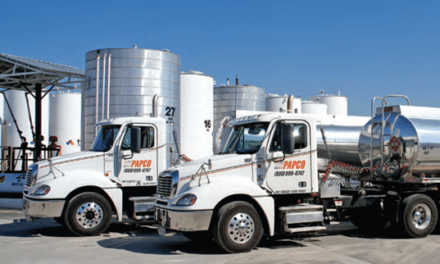By Charles Davis, DTN
As a fuel distributor, you could be cheating yourself of valuable volume as your fuel expands and contracts with temperature. Understanding and managing every aspect of your fuel purchasing is critical in order to maintain or improve your margins. Tough negotiation and volume purchases are obviously core strategies in effective fuel buying and selling, yet there is another strategy that can contribute to improving your fuel margins.
To be truly effective, you must be aware of how volumetric fluctuations caused by product temperature can impact product volumes and pricing. If you are not considering temperature variations you are subjecting your company to great risk, particularly in states where suppliers buy in bulk based on temperature-corrected (net) volume but are required to sell and report to tax authorities based on the actual (gross) volume.
What Exactly is Temperature Correction?
In order to understand how to best leverage temperature correction data, it helps to clearly understand the concept and science. Like all liquids, when refined fuels cool, they condense and their mass increases. Conversely, when fuels warm, they expand, occupy more space and their mass decreases. While this is inconsequential at the retail level and impractical to address, that is not the case with wholesale volumes. If you are buying or selling fuel based on gross volume—its actual volume at the current temperature—you need to understand how the temperature affects the value of each of those gallons. After all, the ultimate value of a fuel is based on the power it provides to an engine, which is driven by the fuel’s mass.
Think of mass as the number of molecules in a given amount of fuel regardless of the amount of space, or volume, that fuel takes up. One gallon of gasoline at 40 F has 1.4% greater mass, 1.4% more molecules and 1.4% more ability to power an engine than one gallon of gasoline at 60 F. Consequently, a 40-degree gallon is worth 1.4% more than a 90-degree gallon.
In order to correct for the density differential caused by the temperature fluctuation, the American Society of Testing and Measurement (ASTM) provides formulas and calculations for the accurate correction of volume based on temperature. Incorrect measurements can easily create a 1% discrepancy in volume, which, on a $2.00 gallon, is an error of $.02 per gallon.
Every evening, pricing managers post gasoline and diesel prices at terminals across the country. Most of these prices contain a “best estimate” of temperature correction, but these estimates are never perfect. The degree that these estimates are imprecise creates financial risk.
One of the ways to generate measurement estimates is to compensate for the weather and ambient temperature fluctuations and other estimated variables. This is currently the preferred method for estimating product temperature; however, the list of ways this can cause inaccuracies is long.
Maximizing Pricing Negotiations with Temperature Correction Data
For many years, buyers and sellers routinely have believed that when the weather changed and their margins grew or narrowed, it was just part of the cost of doing business. Some businesses began to try to compensate for seasonal temperature variations by adjusting their price differentials throughout the year to account for the changing density (mass) of the fuel they sold. But this was only a small improvement and didn’t reflect day-to-day temperature fluctuations, nor was it consistently accurate.
With the advent of annual formula-based price contracts, many sellers began to encourage ratable liftings. However, during the early use of formula-based price contracts, little consideration was given to the net-versus-gross problem, so these contracts locked in an added layer of risk and complexity for businesses required to sell in gross gallons.
Some buyers and sellers developed ways over time to deal with this problem in contracts, but there were still no best practices or industry standards for gross-gallon formula transactions. To account for variations in density according to temperature, some businesses opted to include an “adder” to prices based on the annual average temperature at a terminal market. Others chose to employ a similar “monthly adder” to prices based on the historical monthly temperature at a terminal market. Elsewhere, some chose to perform manual reconciliation at the end of the month based on what actual temperatures had been, or to make no adjustment at all.
DTN’s approach to the issue was to engineer a modern solution that delivers accurate, real-time temperature data right from the terminal.
Real-time information is critical to accurately account for temperature correction. When counterparties are equipped with that data, they will be able to rely on solutions that aggregate the gross and net volumes at the product and terminal level. By doing this, outlier bills of lading (BOLs) can be filtered out, reports can run at set intervals throughout the day and our industry can rely on standardized, nearly real-time data that reflects all time zones and activities each day.
Rating and reporting gallons precisely at the time of lifting means buyers and sellers can have a more consistent and extremely reliable source for temperature-based volume adjustment factors, which enable improved pricing processes and enhance margins.
All purchasers and suppliers should evaluate if they are able to access and use consistent, accurate volumetric fuel measurements. Industry research indicates that many overlook this detail and this oversight has serious implications. Small errors in measurement, or no consideration at all for temperature correction, can result in unintended and unnecessary risk for both buyers and sellers.
 Charles Davis is the vice president of energy sales at DTN. Previously he served in business development roles for Argus Media and ExxonMobil. In his role at DTN, Charles works closely with customers in the energy market to bring them insights that help manage risk and increase margins. He recently launched the new Temperature Correction Index product for the company.
Charles Davis is the vice president of energy sales at DTN. Previously he served in business development roles for Argus Media and ExxonMobil. In his role at DTN, Charles works closely with customers in the energy market to bring them insights that help manage risk and increase margins. He recently launched the new Temperature Correction Index product for the company.









